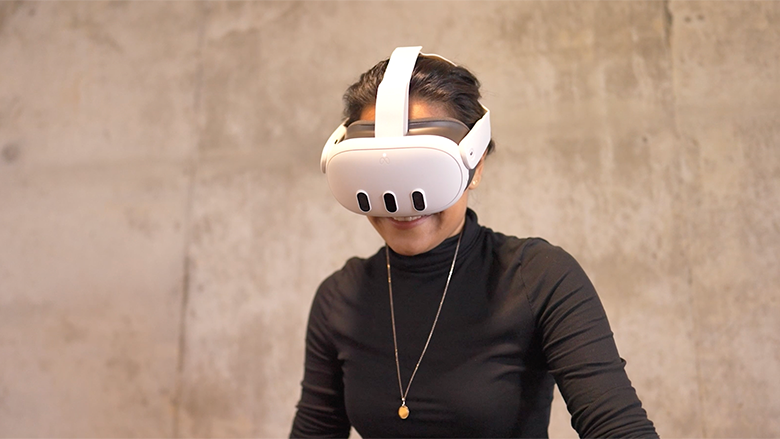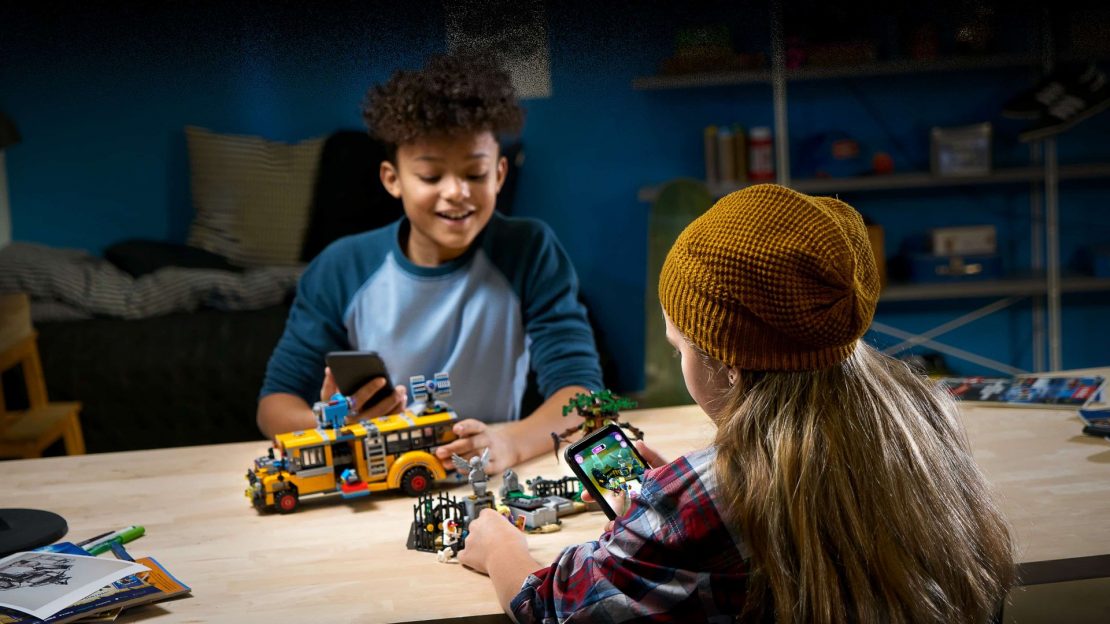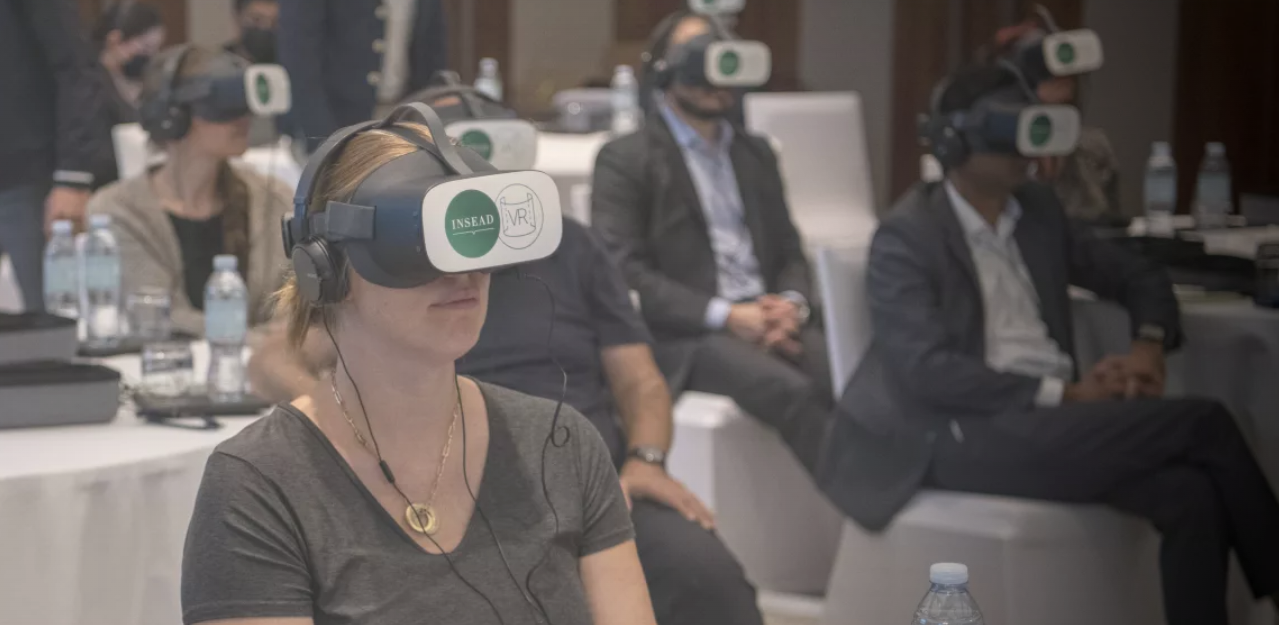It’s been two years since Mark Zuckerberg laid out our vision for the metaverse: a set of interconnected digital spaces that lets you do things you simply can’t do in the physical world—like hanging out with avatars of friends or family no matter where they happen to be in the world and feeling like you’re right there in the same space. It’s a big bet and a long-term ambition—and parts of the metaverse are already with us, with people reaping the benefits of new social experiences, educational tools, and more. Today, we’re shining a light on some of the early pioneers who have embraced immersive technologies and are using them to solve real-world problems.
Building Solid Foundations Through XR
A trade organization representing a traditionally very “hands-on” and physical workforce, Associated Builders & Contractors is using immersive technologies for training as well as helping to plan, scope, and prepare to build projects.
“It’s having an impact today on safety, efficiency, upskilling, recruitment, and overall productivity for the construction industry as something that is going to be seamless,” says VP of Construction Technology & Innovation Matt Abeles. “I’ve seen it help people win work through some of the marketing efforts that immersive reality can do and give an owner an experience of what is possible and you get to see what the possibilities are for a big project.”
From marketing efforts and showcasing a built environment for a customer before ever breaking ground to real-time collaboration across distance and even recruiting efforts, Abeles points to immersive technologies as a key source of innovation for his industry moving forward. During COVID-related shutdowns, VR helped the construction industry maintain momentum in its educational efforts, Abeles adds, helping people grow and develop their careers in the field without incurring additional opportunity costs.
Looking at more recent technology like the Ray-Ban Meta smart glasses collection, Abeles sees a potential parallel with the safety goggles that are ubiquitous in his industry.
“Everybody in construction needs to wear safety goggles on a job site,” he explains. “That is a part of their daily lives, so if you incorporate augmented reality into that, you can increase the likelihood that everyone in construction is going to go home to their families after a day at work. There is no price you can put on their safety, and immersive reality is going to play a giant role in that.”
VR as Educational Praxis
“The world of education is a hard world to change—things have been done the same way for a very long time,” says Lighthaus CEO & Founder David Sarno, whose company creates educational VR content, like the Stanford Virtual Heart. “The interesting thing about virtual reality is when we go into a school and show it to teachers and teachers start using it, we see them wanting to adopt it quickly. It’s an example of something being able to change very quickly because it is so much more powerful than the old way it was done. We do feel like we’re tapping into a profoundly new way to teach students and to expose them to a variety of different subjects.”
We’ve seen the value of VR as an educational and training tool over the years, from retail to the medical field. And now, PrismsVR is taking the conversation to foundational subjects like science and math, delivering a VR learning platform where students learn core concepts spatially, physically, and steeped in real-world contexts. They’re specifically targeting bottleneck topics that are often tackled through rote memorization rather than cultivating a deep understanding.
“It’s rapidly changing the conversation around what education is and how it ought to be delivered,” says PrismsVR CEO & Founder Anurupa Ganguly. “We are moving from a mental model where kids memorize and they produce answers to one where they experience, they make sense of, and they solve problems. And it’s that conversation that has been the most valuable in changing teacher and instructional practice.”
“Virtual reality is kind of unparalleled for being able to experience and see processes and places that you could never go and do things that you could never do,” adds Sarno. “That really will have a place in almost any subject that you can imagine. And as these devices become more accessible and affordable, they’ll just become part of the learning landscape in the same way that so many other technologies have, including artificial intelligence.”
In a randomized control trial, PrismsVR saw an 11% increase between the control and VR test groups on Algebra 1 scores. While it’s an early study, the results are promising, and PrismsVR plans to conduct much larger randomized control trials in the future. As Ganguly notes, “It’s a really seminal finding to show that when you teach a really core subject like Algebra 1 through problems, through physicality, and through moving from concrete to abstract, you can see exponential impact on learning outcomes in a very short amount of time.”
Ganguly sees a world where students will learn through multiple modalities, leading to a new generation of people who love math and have the confidence and skills to pursue a career in applied mathematics should they so choose.
“We’re seeing huge improvements in teacher engagement, teacher satisfaction, them wanting to come to work every day,” adds Ganguly. “We’re seeing kids wanting to be in school. Most importantly, students are saying, ‘I know I am learning this, and I now understand the concept. I am not going to forget it in six months because I forget where it came from.’ It’s very first principles-driven now.”
“For us, it’s really changing the game for how science is taught to students,” Sarno notes. “And what we can do is unlock the wonder of nature and the universe by bringing students into science and bringing them into the body, into a cell to see DNA, or understand chemistry by interacting with molecules and making compounds and really understanding that our world is made up of science—the entire universe and nature and everything around us. To light that spark of wonder about nature and science is what we are most excited about and feel like we can do in a way that hasn’t been possible before.”
Far from a flash in the pan, VR for education seems to have real staying power—and it catches on in classroom contexts faster than you might think.
“What we keep seeing when we go into schools is that one teacher will use immersive learning, and then the teacher down the hall will hear about it and then they’ll want to use it,” Sarno explains. “And suddenly all the science teachers at this school are using it. It has this kind of viral, accelerating effect of interest because it’s so powerful and exciting. And it’s not just a one-off. They want to use it the next semester, and then they want to use it the next year. So it quickly becomes adopted by teachers as a powerful tool to keep their students interested and excited.”
Ultimately, the benefits of VR extend well beyond the classroom, paving the way for positive employment outcomes across the board.
“What excites me most is the potential for teachers and kids to love school again: the joy of learning, the joy of sense-making, and the joy of success,” Ganguly says. “Because it’s not just about fun, interesting problems. It’s about gaining fluency in standards-based proficiencies on tests that are tied to future opportunity.”
“Virtual reality isn’t just about bringing people to another place: It’s about giving them a whole suite of different ways they can interact with what they are learning,” adds Sarno. “They can reach out and touch and grab or build or look inside, and that is what really drives high-quality learning is for students to be able to try things and do things and explore and discover. And immersive learning really unlocks a whole array of ways that you’re going to be able to do that.”
Immersive Entrepreneurship & the Future of Small Businesses
As a growing number of industries begin to adopt immersive technologies, using and becoming well-versed in those technologies will become increasingly important for companies and individuals to not only survive but continue to thrive. And according to the Small Business & Entrepreneurship Council, small and medium-sized businesses and entrepreneurs should begin tapping into the metaverse today to ensure both economic growth and competitiveness in the future.
“Immersive technologies are having an extraordinary impact, I know, for the business community, for small business owners and entrepreneurs, in helping them do things more effectively, more creatively, and to compete on a level playing field with larger businesses—and just to do things more productively,” says President & CEO Karen Kerrigan. “The impact has been a game-changer for small businesses and entrepreneurs.”
Looking ahead, Kerrigan sees the adoption of immersive technologies as not only beneficial but, quite simply, as table stakes.
“Just like email and the internet is foundational to any business and now they are adopting AI tools, I think immersive technologies are going to be embedded across most of the operations of small businesses owners and entrepreneurs,” she says. “There’s no doubt about it in my mind: If they’re not using immersive technologies, they’re going to be left behind.”
From trade industries to the fine arts and from entrepreneurs to the enterprise, immersive technologies are poised to revolutionize the way we work, play, and engage with the world around us. These technologies can help us break down barriers of time and space, connecting with people across the globe and feeling like we’re physically present with them, despite thousands of miles of distance. And whether you use the metaverse to hang out with friends, spend quality time with family, or collaborate with coworkers, we think it’s a future worth betting on.
Quelle:




